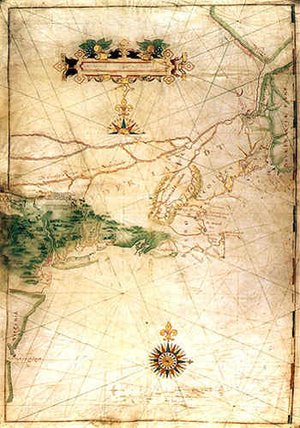Adriaen Block
|
|
Adriaen Block (1567–1627) was a Dutch private fur trader and navigator who explored the coastal and river valley areas between present-day New Jersey and Massachusetts during four voyages from 1611 to 1614, following the 1609 expedition by Henry Hudson. He is noted for establishing early trade with the Native Americans, and for the 1614 map of his last voyage on which many features of the mid-Atlantic region appear for the first time, and on which the term New Netherland is first applied to the region. He is credited with being the first European to enter Long Island Sound and the Connecticut River and to determine that Manhattan and Long Island are islands.
| Contents |
Block's Expeditions
Early Voyages (1611-1612)
Following Hudson's contact with the Native Americans in the Hudson Valley in 1609, the Dutch merchants in Amsterdam had deemed the area worth exploring as a potential source of trade for beaver pelts, which were a lucrative market in Europe at the time.
The following year in 1610, a ship from Monnikendam, skipper Symen Lambertsz Mau, perished in the Hudson River and the following year in 1611, at the commission of a group of Lutheran merchants, Block and fellow captain Hendrick Christiaensen revisited the area Hudson had explored, bringing back furs and two sons of a native sachem. The prospect of successful fur trade prompted the States General, the Governing body of the Dutch Republic, to issue a statement, on March 27, 1614, stipulating that the discoverers of new countries, harbors, and passages would be given a exclusive patent good for four voyages, to be undertaken within three years, to the territories discovered, if the applicant would submit a detailed report within 14 days after his return.
The 1614 Expedition
In 1614, he made a fourth voyage to the lower Hudson in the Tyger accompanied by several other ships especially equipped for trading. While moored along southern Manhattan, the Tyger was accidentally destroyed by fire. Over the winter, he and his men, with help from the Lenape, built the 42-foot ship 16-ton Onrust (Trouble or Restless).
In this latter ship, he explored the East River and was the first known European to navigate the Hellegat (now called Hell Gate) and to enter Long Island Sound. Travelling along Long Island Sound, entered the Housatonic River (which he named "River of Red Hills") and the Connecticut River, which he explored it at least as far as present day Hartford, sixty miles up the river [1] (http://www.bio.umass.edu/biology/conn.river/block.html). Leaving Long Island Sound, he charted Block Island, which is named for him and Narragansett Bay, where he possibly named "Roode Eylandt" after the red (Dutch roode) color of its soil [2] (http://international.loc.gov/intldl/awkbhtml/kb-1/kb-1-2-5.html). On Cape Cod, the rendezvoused with one of the other ships of the expedition and left the Onrust behind before returning to Europe.
United New Netherland Company
Upon returning, Block compiled a map of his voyage together with known information of the time. The Block map was the first to apply the name "New Netherland" to area between English Virginia and French Canada, as well as the first to show Long Island as an island.
On October 11, 1614, Block, Christiaensen, and a group of twelve other merchants presented to the States General as a petition to receive exclusive trading priviliges for the area. Their company, the newly-formed United New Netherland Company, was granted exclusive rights for three years to trade between the 40th parallel and 45th parallel [3] (http://www.colonialwarsct.org/1614.htm).
See also
External links
- Society of Colonial Wars of the State of Connecticut (http://www.colonialwarsct.org/1614.htm)
- Long Island History (http://www.newsday.com/extras/lihistory/)
- The First Dutch Settlers (http://odur.let.rug.nl/~usa/E/newnetherlands/nl2.htm)
- Univ. of Massachusetts Biography (http://www.bio.umass.edu/biology/conn.river/block.html)
- Dutch Place Names (http://international.loc.gov/intldl/awkbhtml/kb-1/kb-1-2-5.html)
- Ships Known to Have Left Netherlands for the New World (http://olivetreegenealogy.com/nn/mm_shipamny.shtml)
- Five Boroughs History: The Coming of the Dutch (http://www.hopefarm.com/5boros.htm)nl:Adriaen Block

